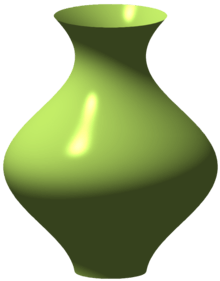Surface of revolution

A surface of revolution is a surface in Euclidean space created by rotating a curve (the generatrix) around an axis of rotation.[1]
Examples of surfaces of revolution generated by a straight line are cylindrical and conical surfaces depending on whether or not the line is parallel to the axis. A circle that is rotated about any diameter generates a sphere of which it is then a great circle, and if the circle is rotated about an axis that does not intersect the interior of a circle, then it generates a torus which does not intersect itself (a ring torus).
Properties
The sections of the surface of revolution made by planes through the axis are called meridional sections. Any meridional section can be considered to be the generatrix in the plane determined by it and the axis.[2]
The sections of the surface of revolution made by planes that are perpendicular to the axis are circles.
Some special cases of hyperboloids (of either one or two sheets) and elliptic paraboloids are surfaces of revolution. These may be identified as those quadratic surfaces all of whose cross sections perpendicular to the axis are circular.
Area formula
If the curve is described by the parametric functions x(t), y(t), with t ranging over some interval [a,b], and the axis of revolution is the y-axis, then the area Ay is given by the integral
provided that x(t) is never negative between the endpoints a and b. This formula is the calculus equivalent of Pappus's centroid theorem.[3] The quantity
comes from the Pythagorean theorem and represents a small segment of the arc of the curve, as in the arc length formula. The quantity 2πx(t) is the path of (the centroid of) this small segment, as required by Pappus' theorem.
Likewise, when the axis of rotation is the x-axis and provided that y(t) is never negative, the area is given by[4]
If the curve is described by the function y = f(x), a ≤ x ≤ b, then the integral becomes
for revolution around the x-axis, and
for revolution around the y-axis (using a ≤ y ≤ b). These come from the above formula.
For example, the spherical surface with unit radius is generated by the curve y(t) = sin(t), x(t) = cos(t), when t ranges over [0,π]. Its area is therefore
For the case of the spherical curve with radius r, y(x) = √r2 − x2 rotated about the x-axis
A minimal surface of revolution is the surface of revolution of the curve between two given points which minimizes surface area.[5] A basic problem in the calculus of variations is finding the curve between two points that produces this minimal surface of revolution.[5]
There are only two minimal surfaces of revolution (surfaces of revolution which are also minimal surfaces): the plane and the catenoid.[6]
Rotating a function
To generate a surface of revolution out of any 2-dimensional scalar function y = f(x), simply make u the function's parameter, set the axis of rotation's function to simply u, then use v to rotate the function around the axis by setting the other two functions equal to f(u) sin v and f(u) cos v. For example, to rotate a function y = f(x) around the x-axis starting from the top of the xz-plane, parameterize it as
for u = x and v ∈ [0,2π].
Geodesics on a surface of revolution
Geodesics on a surface of revolution are governed by Clairaut's relation.
Toroids

A surface of revolution with a hole in, where the axis of revolution does not intersect the surface, is called a toroid.[7] For example, when a rectangle is rotated around an axis parallel to one of its edges, then a hollow square-section ring is produced. If the revolved figure is a circle, then the object is called a torus.
Applications of surfaces of revolution
The use of surfaces of revolution is essential in many fields in physics and engineering. When certain objects are designed digitally, revolutions like these can be used to determine surface area without the use of measuring the length and radius of the object being designed.
See also
- Channel surface, a generalisation of a surface of revolution
- Gabriel's Horn
- Liouville surface, another generalization of a surface of revolution
- Solid of revolution
- Surface integral
- Generalized helicoid
References
- ↑ Middlemiss; Marks; Smart. "15-4. Surfaces of Revolution". Analytic Geometry (3rd ed.). p. 378. LCCN 68015472.
- ↑ Wilson, W.A.; Tracey, J.I. (1925), Analytic Geometry (Revised ed.), D.C. Heath and Co., p. 227
- ↑ Thomas, George B. "6.7: Area of a Surface of Revolution; 6.11: The Theorems of Pappus". Calculus (3rd ed.). p. 206–209, 217–219. LCCN 69016407.
- ↑ Singh, R.R. (1993). Engineering Mathematics (6 ed.). Tata McGraw-Hill. p. 6.90. ISBN 0-07-014615-2.
- 1 2 Weisstein, Eric W. "Minimal Surface of Revolution". MathWorld.
- ↑ Weisstein, Eric W. "Catenoid". MathWorld.
- ↑ Weisstein, Eric W. "Toroid". MathWorld.
External links
- "Surface de révolution". Encyclopédie des Formes Mathématiques Remarquables (in French).